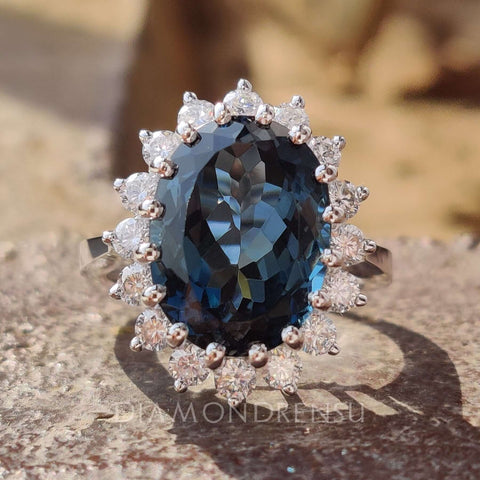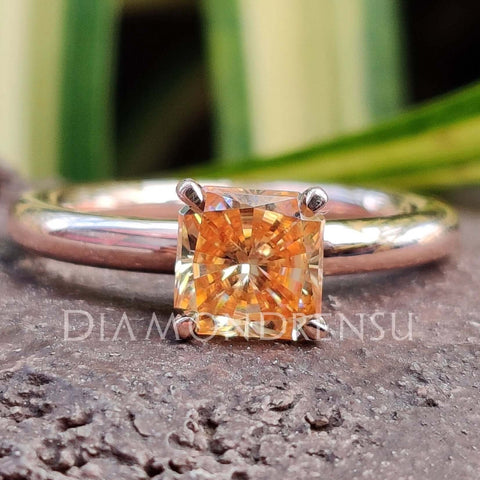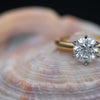
What is a Rose Cut Diamond: Unveiling the Vintage Charm
A rose cut diamond is a unique style of gem cutting that dates back to the early 1500s. Emphasized by its flat bottom and dome-shaped top, which is covered in triangular facets, this cut resembles the petals of a rosebud about to bloom.
It generally has anywhere from three to 24 facets, a notable variation from the typical brilliant cuts of modern times. The rose cut was immensely popular during the Georgian and Victorian eras, and while it fell out of favor in the early 20th century when more reflective cuts gained popularity, it's currently enjoying a resurgence among those looking for a vintage or antique aesthetic in their jewelry.
Unlike modern diamond cuts that are valued for their ability to reflect light internally and produce brilliance, the rose cut's beauty lies in its subtlety and soft, sultry luster. The cutting style is designed to present the stone's translucent qualities rather than its reflectivity, which often results in a diamond that feels sophisticated and understated. This cut's distinctive shape and facet pattern allow you to glimpse right through the stone, affording a depth not typically found in contemporary cuts.
Your knowledge and appreciation of jewelry can be enriched by understanding the history and characteristics of the rose cut diamond. This cut represents a storied chapter in the evolution of diamond cutting, reflecting social changes and shifting tastes in jewelry fashion over centuries. Whether you’re a collector, a history buff, or simply someone who appreciates the beauty and craft of diamonds, the rose cut is a testament to the timeless allure of diamonds.
Historical Context

As you explore the rose cut diamond, you'll delve into a rich history marked by changing tastes and technological advancements. Through its evolution and varying popularity, the rose cut remains a testament to the artistry of diamond cutting throughout the ages.
Origins and Evolution
The rose cut diamond traces its origins back over 500 years. First emerging in the 16th century, this cut embodied the beauty and craftsmanship of early diamond cutting techniques. Unlike the brilliant cuts of today, a rose cut diamond features a flat bottom with facets rising to a peak resembling the petals unfurling in a rosebud. This distinctive style reflects a time when diamonds were admired for their lustrous sheen rather than their ability to reflect light.
Initially, craftsmen shaped these diamonds to maximize the size of the stone rather than its refractive qualities, due to the limited diamond-cutting technology available during that era. The cutting method involved symmetrical arrangements of triangular facets, which can vary in number. This facet pattern enhances the subtle glow of the diamond, offering a unique vintage appeal that is distinct from the sparkling brilliance of modern cuts.
Popularity Through Eras
During the Georgian and Victorian eras, the rose cut diamond reached a peak in popularity. Its romantic aesthetic suited the ornate jewelry fashion of the times, especially in the 18th and early 19th centuries.
- Georgian Era: Jewelers frequently set rose cut diamonds in silver to enhance their color and mimic the softer candlelight conditions under which they would be viewed. The designs were often elaborate and included multiple smaller rose cut diamonds to create intricate patterns.
- Victorian Era: In the Victorian era, the rose cut became symbolic of the romantic and sentimental expressions of the time. Its usage in engagement rings and brooches was particularly prevalent.
Moving into the Edwardian era, jewelry design began to shift, favoring more precise and intricate cuts as advancements in diamond-cutting techniques arose. Yet, despite these changes and the introduction of new cuts, the rose cut maintained its appeal among those who cherished its antique charm.
In today's market, antique rose cut diamonds from these periods are highly sought after, not just for their historical significance but for their timeless beauty and representation of a bygone age of elegance.
Characteristics of Rose Cut Diamonds
Your appreciation for rose cut diamonds will grow as you understand their defining characteristics, which stem from a blending of historical craftsmanship and aesthetic appeal.
| Characteristic | Description |
|---|---|
| Cut Style | Rose cut diamonds have a flat base and a domed crown with triangular facets, resembling the petals of a rosebud. |
| Facets | Usually feature a varying number of triangular facets, often ranging from 3 to 24. |
| Shape | The traditional rose cut is round, but variations can include oval, pear, and other shapes. |
| Table | May have a large, flat table with no culet, emphasizing the crown of the diamond. |
| Popularity | Experienced a resurgence in popularity in contemporary and vintage-inspired jewelry designs. |
| Historical Significance | Originally popular in the 16th century, rose cuts are associated with antique and vintage jewelry. |
| Brilliance | Produces a softer, more subtle brilliance compared to modern brilliant cuts. |
Unique Facet Structure
Rose cut diamonds distinguish themselves with a unique facet structure, arranged to resemble the petals of a rosebud blooming. These stones typically have a flat bottom with a domed top that's covered in triangular facets, often 24 in total, which converge to a point. This facet arrangement enhances the stone's reflective qualities, even though it lacks the pavilion the lower portion of a diamond which is common in more modern cuts.
Distinctive Shape
The shape of a rose cut diamond contributes significantly to its charm. Traditionally, they exhibit a round or oval silhouette, but can also be found in more free-form or pear shapes, accommodating a range of personal styles. The absence of a deep pavilion means that rose cut diamonds lie relatively flat against the skin, giving them a subtle, sophisticated presence.
Variations in Clarity and Color
The clarity and color of rose cut diamonds can vary widely, and they are often more included than other diamond cuts, which might be perceived as flaws but actually add to their uniqueness. Due to the larger, open facets, the true color of the stone can be appreciated without the distraction of brilliance that characterizes many modern cuts. It's this simplicity and the way rose cut diamonds capture light that endear them to lovers of antique and understated jewelry.
Aesthetic Appeal
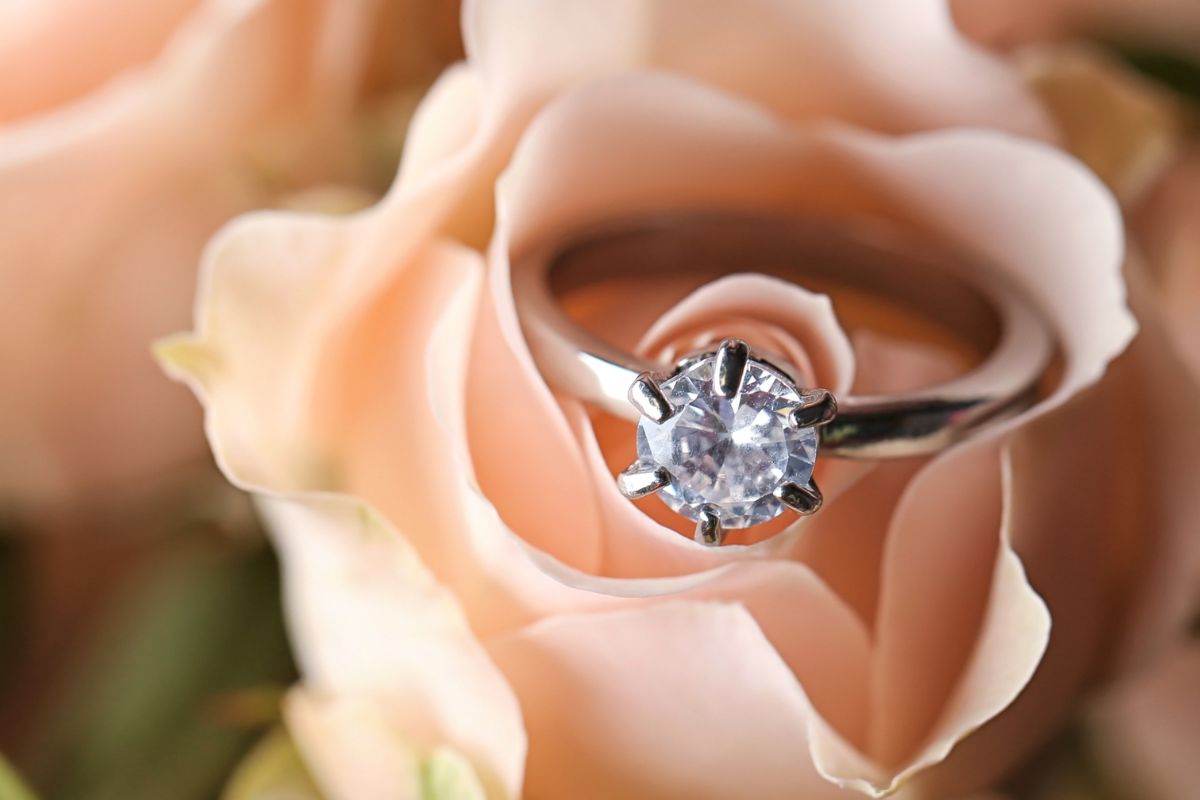
Rose cut diamonds captivate with their unmistakable elegance and simplicity. Their unique facets echo the soft glow of candlelight, embodying a gentle allure that is both historical and romantic.
Romantic Allure
Your rose cut diamond embodies a rich history that dates back to the 1500s, symbolizing romantic allure with its timeless design. Unlike modern brilliant cuts, the rose cut's subtle facets and flat bottom are reminiscent of the petals of a rose, from which it derives its name. This connection to the quintessentially romantic flower lends the cut a deep sense of nostalgia and emotion.
Candlelight Effect
The rose cut's design truly shines in soft lighting, akin to the ambient glow of candlelight. Its facets are specifically engineered to maximize brilliance in low-light conditions, giving you a soft, subtle sparkle that is vastly different from the aggressive shine of contemporary cuts. Emphasizing allure rather than sheer brilliance, your diamond revels in its unique candlelight effect, a testament to the cut's historical roots when diamonds were showcased under the glow of lamps and candles.
Rose Cut Diamond in Jewelry
The rose cut diamond, known for its flat bottom and faceted top, is a classic choice that complements various jewelry styles, especially in engagement rings and settings that appreciate vintage aesthetics.
Engagement Rings and Settings
When you're considering a rose cut engagement ring, you'll find the diamond's signature dome shape allows for a large surface area that maximizes the stone's brilliance despite fewer facets than round or brilliant cuts.
- Settings: The bezel setting is particularly popular for rose cut diamonds as it secures the stone and highlights its unique shape.
- Halo Designs: A halo of smaller diamonds can enhance the rose cut’s presence on your finger, making it a statement piece with both sparkle and historical charm.
Use in Antique and Vintage Jewelry
Your interest in vintage jewelry might lead you to discover that rose cut diamonds have been adorning pieces since the early 1500s. The allure of antique jewelry often lies in the rose cut’s subtle glow and historical significance.
- Antique Collections: Look for rose cut diamonds in pieces from Georgian, Victorian, and Edwardian eras, where they were often set in silver to enhance reflection.
- Modern Reproductions: Jewelers today might incorporate rose cut diamonds into new designs to evoke the antique look sought after by vintage jewelry enthusiasts.
Quality and Evaluation
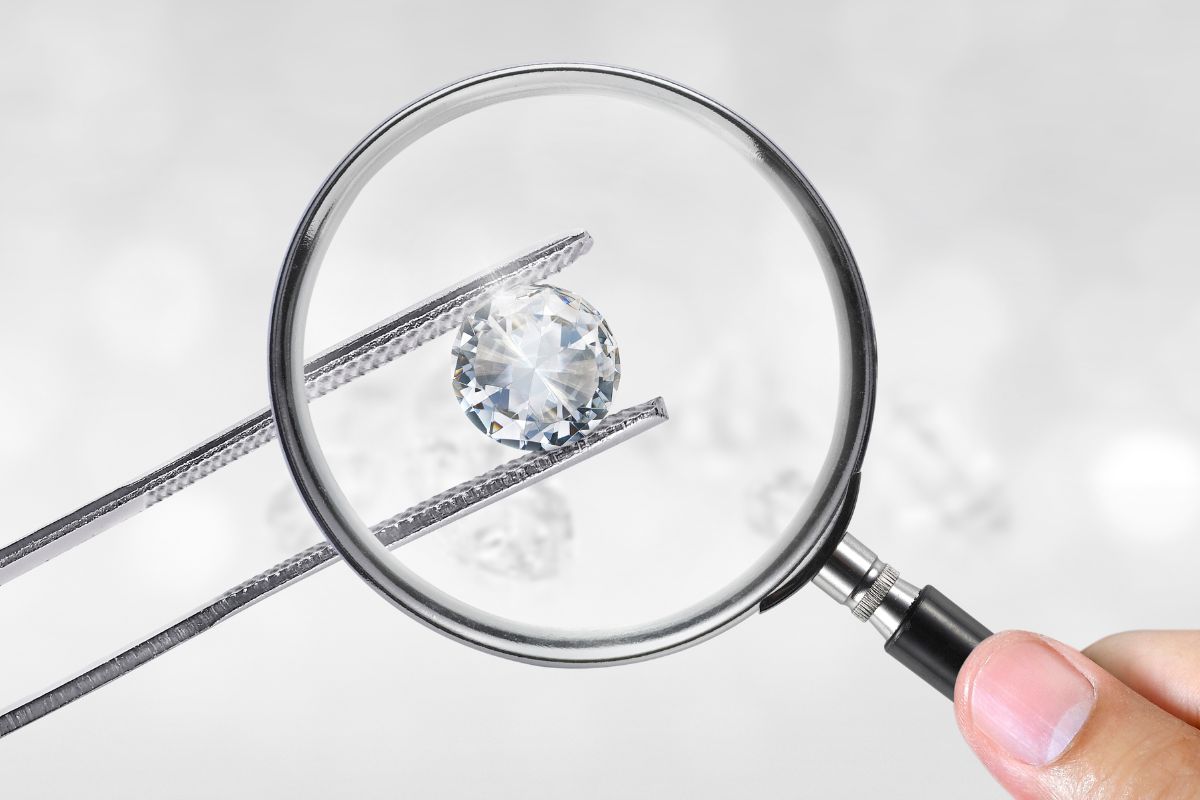
When evaluating a rose cut diamond, your focus should be on clarity and cut, as well as the significance of the carat weight. These factors deeply influence its value and aesthetic.
Assessing Clarity and Cut
Rose cut diamonds are renowned for their flat bottom and dome-shaped top, characterized by multiple triangular facets converging to a point. Unlike other diamond cuts, the rose cut has a unique structure that can affect its clarity. When assessing clarity, the Gemological Institute of America (GIA) clarity grade can serve as a reliable reference. Visible inclusions within a rose cut diamond can diminish its value, but because of its cut style, some inclusions can be masked by the stone's facets. Additionally, the proportions of the diamond, including the symmetry of its facets and the presence of a flat or slightly domed table, play a crucial role in reflecting light and creating its subdued sparkle.
- Proportions to check:
- Symmetry of facets
- Flatness of the table
When evaluating the cut of a rose cut diamond, you'll notice they don't have the standard grading like modern brilliant cuts. Instead, assess the artisanal craftsmanship and how the facets interact with light. The artistry of the cut affects the overall appearance and can contribute to the diamond's luminous quality.
Importance of Carat Weight
Carat weight significantly impacts the value of a rose cut diamond. However, due to the shallower depth of these diamonds, a rose cut diamond may appear larger than other diamonds of the same weight. It's helpful to remember that carat refers to weight, not size, and in the case of rose cuts, this could mean a larger-looking diamond for the same carat when compared to deeper-cut diamonds.
- Carat weight facts:
- One carat equals 0.2 grams.
- Carat weight alone does not determine value clarity and cut are also key factors.
When you're looking at carat weight, consider it in tandem with the dimensions of the diamond to understand its overall impact. Rose cut diamonds have a unique charm and their value can only be truly assessed by considering these integral aspects: cut, clarity, and carat weight combined.
Comparative Analysis
When considering diamond cuts, it's essential to understand how different styles such as the rose cut and brilliant cut diamonds compare, especially regarding their facets, light performance, and historic appeal.
Rose Cut vs. Brilliant Cut Diamonds
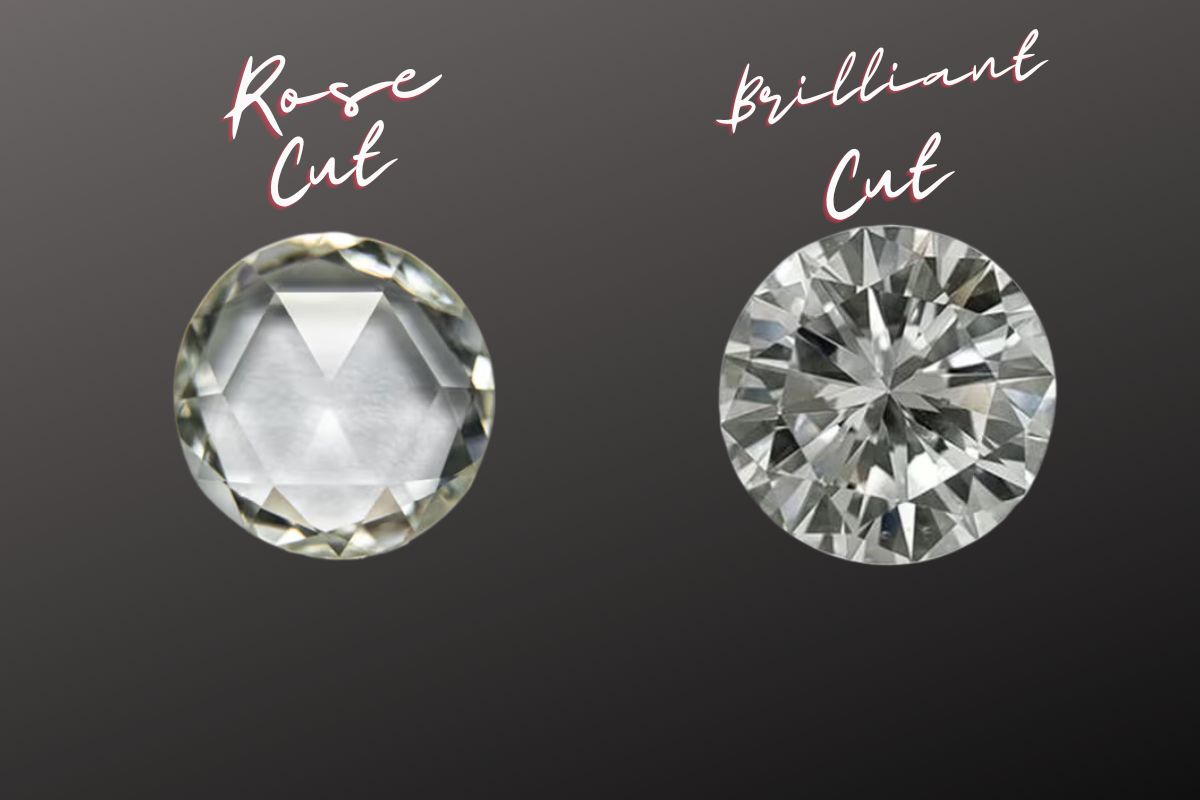
Rose Cut Diamonds:
- Facets: Typically 3 to 24 triangular facets
- Peak: Flat bottom with a dome-shaped top, resembling the petals of a rose
- Light Performance: Subtle, soft glow rather than a sharp sparkle
Brilliant Cut Diamonds:
- Facets: Standard 58 facets (including the culet)
- Peak: Conical bottom with a rounded top designed for maximum light refraction
- Light Performance: Known for exceptional brilliance and sparkle
The rose cut dates back to the early 1500s and exemplifies vintage charm. In contrast, the modern round brilliant cut, perfected in the early 20th century, maximizes light return to create that signature sparkle associated with brilliant cut diamonds.
Antique Cuts in Modern Settings
Old Mine Cut and Old European Cut:
- Resemblance: Both resemble the modern round brilliant cut but with less symmetry and precision
- Appeal: Provide an authentic vintage feel that many find desirable for unique engagement rings
In today's jewelry market, rose cut and other antique diamonds like the old mine cut and old European cut are gaining popularity when set in contemporary rings. The combination of historical cuts with modern designs offers you a blend of timeless elegance and trendy sophistication.
Practical Considerations
When selecting a rose cut diamond, you need to take into account its unique characteristics that may impact its durability and how you will maintain it over time.
Durability and Wearability
Rose cut diamonds have a flatter profile than other cuts, which means they have a lower profile on the hand. Although the flat profile may make them less prone to chipping or snagging compared to higher profile diamonds, it is still important to consider the inclusions and imperfections that could affect the stone's resilience. A diamond's luster and ability to reflect light is not solely dependent on surface smoothness but also its intrinsic quality and cut.
Care and Maintenance
The care and maintenance of your rose cut diamond should be done with precision. Due to the larger facets and the openness of the cut, dirt and oils can more easily accumulate and may dull the stone's luster. It's recommended to gently clean your diamond with a solution of water and mild dish soap, using a soft brush to cleanse the stone's surface. Regular checks with a jeweler can help ensure that any imperfections do not compromise the diamond's condition.
Purchasing Guidance
When you're looking to buy a rose cut diamond, understanding the subtleties that contribute to its value can significantly impact your choice and investment.
Selecting a Rose Cut Diamond
Before choosing your diamond, examine the specific shape and facet pattern, as these aspects are central to a rose cut diamond's allure. The rose cut can appear in a variety of shapes, including round, pear, and oval, each presenting a unique appeal. Your priority should be finding a trusted vendor; a reputable seller will provide you with a variety of high-quality rose cut diamonds from which you can select based on personal preference and budget.
- Diamond Shape: Look for symmetry and proportionality in the shape you prefer.
- Vendor Trust: Choose vendors with verified reviews and transparent practices.
Factors Affecting Value
The value of a rose cut diamond isn't just determined by its carat weight but also by the complexity of its cut and its rarity. These diamonds typically have a flat base and a dome-shaped crown composed of triangular facets that mimic the petals of a rose, hence the name. The cut's complexity, particularly the precision of each facet, can enhance the diamond’s brilliance and therefore its value.
- Complexity: Evaluate the precision of the cut and the number of facets.
- Rarity: Understand that certain shapes or sizes of rose cut diamonds may be more sought after.
When assessing diamonds for potential diamond rings or other jewelry, remember that each rose cut diamond is unique. Use this to your advantage and select a stone that resonates with your personal taste and compliments the desired setting.
The Future of Rose Cut Diamonds
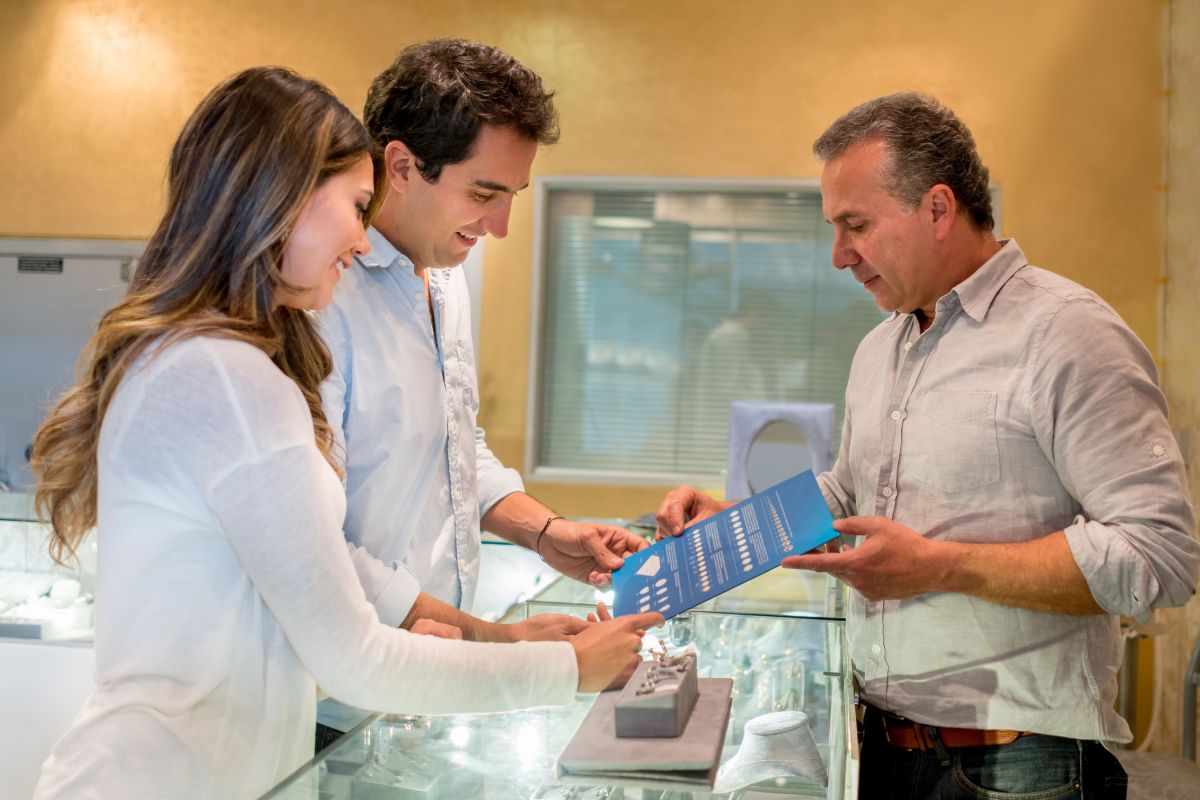
Rose-cut diamonds have been cherished for their vintage charm and unique qualities. As you look toward the future, expect to see this historic diamond style continue to weave its way into modern jewelry design with renewed vigor.
Contemporary Trends
In recent years, there's been a resurgence in the popularity of rose-cut diamonds. Their distinct facet pattern, which resembles the petals of a rose bud, makes them a favored choice for those seeking an alternative to the modern brilliant cut diamond. Designers are combining the antique allure of rose-cut diamonds with contemporary settings, creating pieces that speak both to tradition and current fashion. The artisanal appearance of these diamonds appeals to a niche market that values individuality and handcrafted aesthetics.
Celebrity Influence and Demand
Celebrities have a substantial impact on the demand for certain diamond cuts, and rose-cut diamonds are no exception. When public figures are spotted wearing these diamonds, it bolsters their desirability among consumers. For example, the engagement ring of a noted A-lister featuring a stunning rose-cut diamond can inspire a trend where these gems become sought after by a wider audience. As celebrities often embrace unconventional choices, the rose-cut diamond's distinctive look provides a perfect means to stand out, further stoking its popularity.
The return of rose-cut diamonds is a testament to the cyclical nature of fashion and the lasting allure of historic gem cuts. Their enduring presence in the jewelry world underscores both their time-honored beauty and their potential for innovative design.
Frequently Asked Questions
Rose cut diamonds are valued and chosen for their antique allure and distinctive style. Understanding their characteristics and value can help you appreciate their unique place in the world of gems.
What determines the value of a rose cut diamond?
The value of a rose cut diamond is governed by its clarity, carat weight, and the quality of the cut, much like other diamond cuts. Its flat base and fewer facets emphasize clarity over brilliance.
How does a rose cut diamond's price compare to other diamond cuts?
A rose cut diamond may be less expensive than other cuts because it often weighs less due to its shallower depth and has a more subdued sparkle that's less in demand than the brilliant cuts.
What are the defining characteristics of a rose cut diamond engagement ring?
A rose cut diamond engagement ring showcases a diamond with a domed top covered in triangular facets and a flat bottom, creating a soft, subtle glow with a vintage appeal.
How do rose cut diamonds differ from brilliant cut diamonds?
Rose cut diamonds typically feature 24 triangular facets and lack a pavilion, which is the cone-like section below the girdle in brilliant cut diamonds, resulting in less fire and more of a glassy luster.
What makes a rose cut diamond a unique choice?
A rose cut diamond's uniqueness lies in its heritage charm and the gentle, romantic shimmer it emits, which differs significantly from the high brilliance and fire of modern cut diamonds.
How can you identify a genuine rose cut diamond?
To identify a genuine rose cut diamond, look for the signature flat bottom and the varying triangle facets that come together at a point at the top, without the typical sparkle of a modern cut.
Checkout some of our top collections:
Leave a comment
Please note, comments must be approved before they are published.








